Mistakes You Might Be Making When Cooking Enchiladas
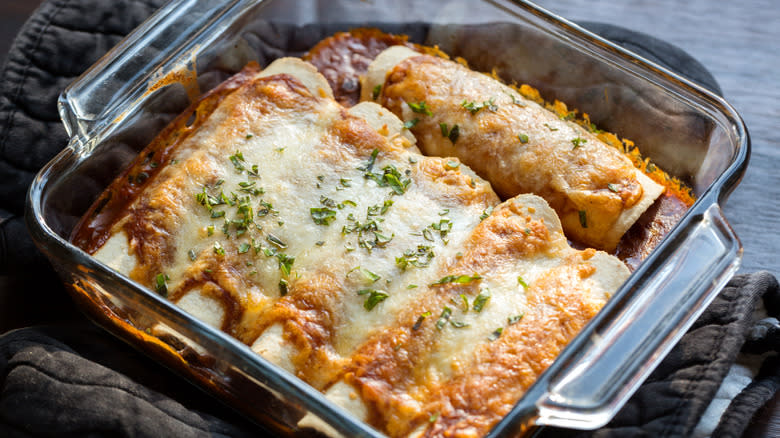
There's nothing quite like the decadent, savory, saucy first bite of delicious enchiladas. Made by filling tortillas with protein, cheese, and add-ons like beans or vegetables, and then baking them in the oven, this meal has been popular for hundreds of years both in Mexico and north of the border in the U.S. And while this Mexican classic can often be found on the menu at your local Tex-Mex or Mexican restaurant, sometimes you may be craving a satisfying, home-cooked meal instead.
With just a few ingredients, you can pull together impressive enchiladas at home that rival even the best restaurant concoctions. Just be sure to avoid the frequent pitfalls home chefs face to achieve the most impressive dish possible. We spoke to experts in the field to discover the top 10 most common mistakes made when cooking enchiladas so that you can make your next batch just like the pros.
Read more: Mistakes You're Making With Your Corn On The Cob
Overcooking Your Protein
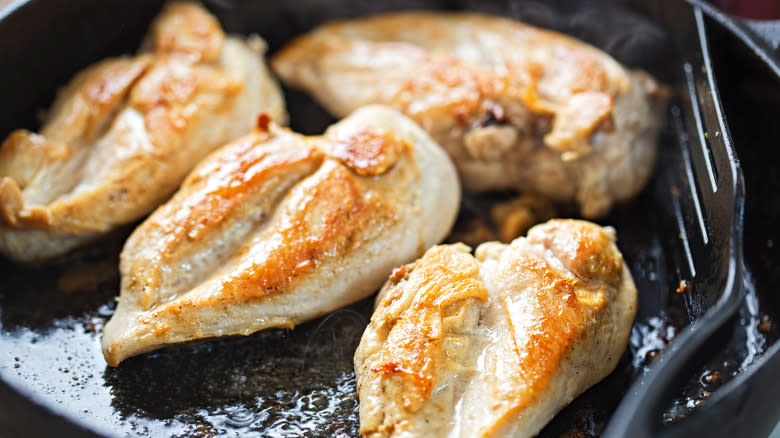
While animal proteins like beef, chicken, pork, or fish are a great option to stuff your enchiladas, cooking any of these proteins incorrectly will result in a filling that isn't as delicious as it could be. Overcooked protein not only leads to a tough, dry texture but can also negatively impact the nutrient content of the meat.
When preparing the protein for your enchilada filling, consider slow-roasting large cuts of meat to help keep it moist and tender. You can also braise, grill, or pan-sear the meat and finish it in the oven at a low temperature for juicier results. Just make sure that it is cooked thoroughly to avoid any foodborne illnesses or unwanted bacteria. Although the safe temperature for different proteins varies, a meat thermometer is an easy and convenient way to ensure your food is fully cooked and ready to add to your enchilada filling.
Using The Wrong Type Of Tortillas
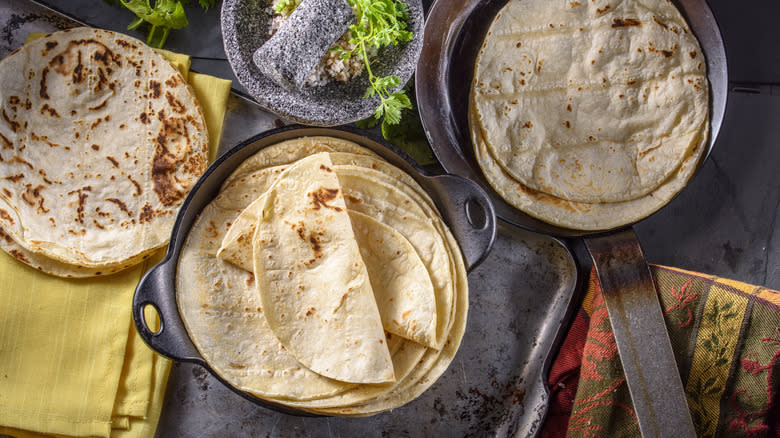
Traditionally, Mexican enchiladas are made with corn tortillas. This Mexican staple has been around for thousands of years, and it was first seen in the early 1500s by European conquistadors arriving in Mexico. While flour tortillas are popular in the U.S. for other Mexican dishes like tacos and burritos, stick with corn for this classic meal. Aside from infusing the dish with a nuttier flavor, corn is also preferred for a more practical reason. Whereas flour tortillas absorb more moisture and are more likely to get soggy when baking, corn tortillas hold their shape better, making them the ideal candidate for enchiladas.
For an even fresher taste, consider making the tortillas from scratch. It only takes three ingredients: masa harina, salt, and water. You'll also need a few kitchen tools including a tortilla press and skillet. That, plus about an hour of your time will yield a plate of delicious tortillas made from scratch. While making corn tortillas is a bit more time-consuming than purchasing premade alternatives at the store, the freshness majorly enhances the enchiladas to create a more complex dish. You can also make extras for other Mexican-inspired dishes or snacks, like tortilla chips.
Choosing The Wrong Enchilada Sauce
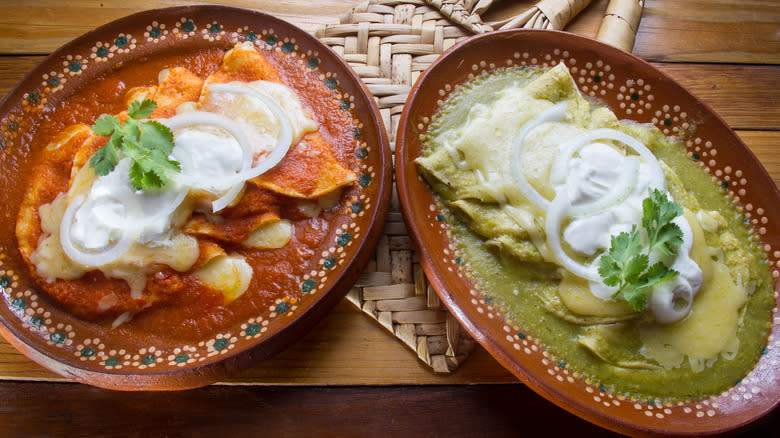
When making enchiladas, there are two main types of sauce to choose from: red and green, made with red and green chilies respectively. Red enchilada sauce has a deeper, earthier flavor because it is prepared with dried chilies like ancho or guajillo peppers, as well as tomatoes. Green enchilada sauce, conversely, is made using fresh green chiles, tomatillos, and cilantro, giving it a brighter and more herbaceous flavor.
Neither sauce is objectively better, so it comes down to personal preference. "I like to make green enchiladas," said Johnny Curiel, chef and owner at Denver-based restaurant Alma Fondia Fina. "I grew up eating only red enchiladas in Jalisco, Mexico, but green is a lot more versatile when it comes to the filling. The sauce is a lot more giving, more acidic, and less viscous."
If you're unsure which sauce to use, consider how it pairs with your protein. Heavier, richer meats like ground beef or steak tend to work better with the smoky flavor of red sauce. Lighter proteins like chicken or fish are best paired with green enchilada sauce. No matter which sauce you choose, experts like Curiel and author and blogger Yvette Marques-Sharpnack agree on one thing: From scratch is almost always better than store-bought: "Homemade sauce is the secret to making delicious enchiladas!"
Not Properly Prepping Your Beans
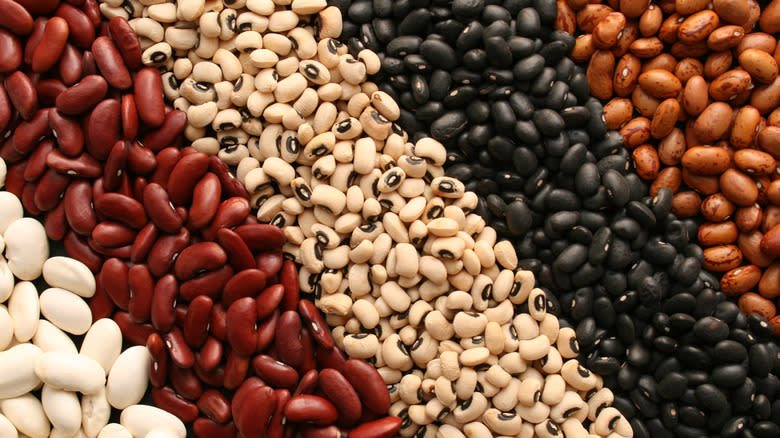
If an enchilada recipe calls for beans, it's important to prep them properly for optimal results. Using the right cooking method will help keep beans tender, balance the flavors, and prevent your enchiladas from becoming soggy as they bake. Black beans are commonly used thanks to their mild and creamy flavor, and for earthier notes, consider swapping in pinto beans (either whole or refried). Meanwhile, for a vegetarian enchilada alternative, you can also skip the meat altogether and choose beans as your primary protein.
When using canned beans, the first step is to drain and thoroughly rinse them to remove excess salt and the bean starch. Although the salt in canned beans is used to help preserve freshness, it can make enchiladas overly salty, so rinsing helps keep the sodium levels in check. You can also prepare dry beans if you prefer. First, soak the dried beans in water and salt to help them cook more evenly. Then add any extra seasoning, cooking liquid, and a bit more salt, and simmer the beans in a pressure cooker until tender (usually between 15 and 35 minutes).
Not Frying Your Tortillas
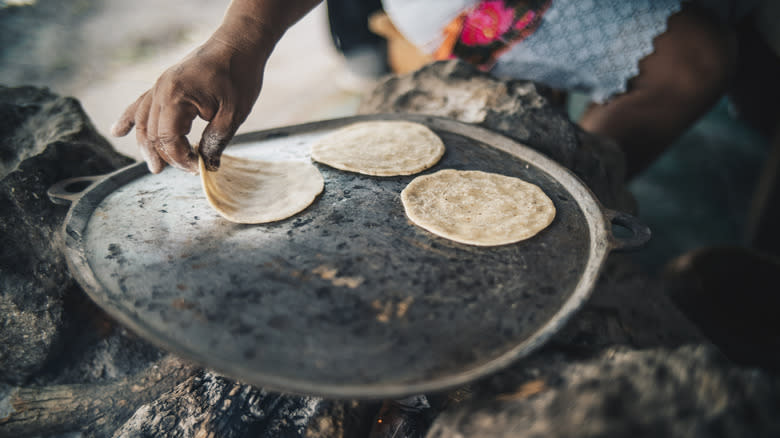
Frying tortillas before assembling enchiladas helps prevent sogginess and infuses more flavor into the dish. It's a simple step that only takes a few minutes, but it makes a huge difference by preventing the tortillas from absorbing too much sauce.
According to experts, it's arguably the most important step for home chefs to take when making enchiladas. When asked what step home chefs should not skip, Marques-Sharpnack said, "Lightly frying corn tortillas and dipping them in warm sauce before assembling." Curiel agreed. "I believe the most important step is pan-frying your tortilla before filling it, making sure that there is a barrier of oil, and crispness before adding any toppings. If there is not enough fat on the tortilla, it will absorb the moisture and result in more of a casserole," he added.
All you need is a bit of vegetable oil, a frying pan, and a pair of tongs. Once the oil is pre-heated, add the tortilla for a few seconds on each side before transferring it to a paper towel to soak up any excess oil. Once complete, the tortillas are prepped and ready to be filled.
Using Too Much Sauce
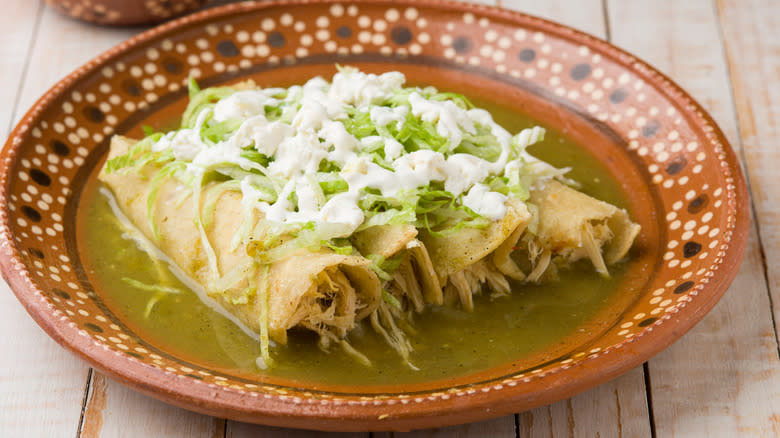
The amount of sauce in your enchiladas depends on whether you want to make an authentic Mexican recipe or prefer a saucier, American alternative. Mexican enchiladas are usually made by pan-frying and briefly dipping the tortillas in sauce before filling them with your protein and veggies of choice. The fried tortillas have a slight fat barrier, ensuring they don't absorb too much sauce and end up a mushy mess after baking.
The Tex-Mex variety, on the other hand, is often intentionally smothered — many popular recipes call for at least a cup of sauce. If the tortillas aren't pan-fried prior to filling, they will absorb large quantities of liquid when covered. While this definitely tastes good and adds more of the sauce's flavor, it can cause the tortillas to become soggy as the sauce releases steam in the oven.
"Soggy enchiladas usually occur when the tortillas are in the sauce for too long," said Marques-Sharpnack. To avoid sogginess caused by excess sauce, she recommends trying a stacked enchilada style instead. "The enchiladas I grew up eating were not rolled, filled, and baked — they were stacked like pancakes. Each corn tortilla was lightly fried in hot oil, then dipped into warm red sauce, placed flat on a plate, and then sprinkled with shredded cheese and finely chopped onions."
Overfilling Your Tortillas
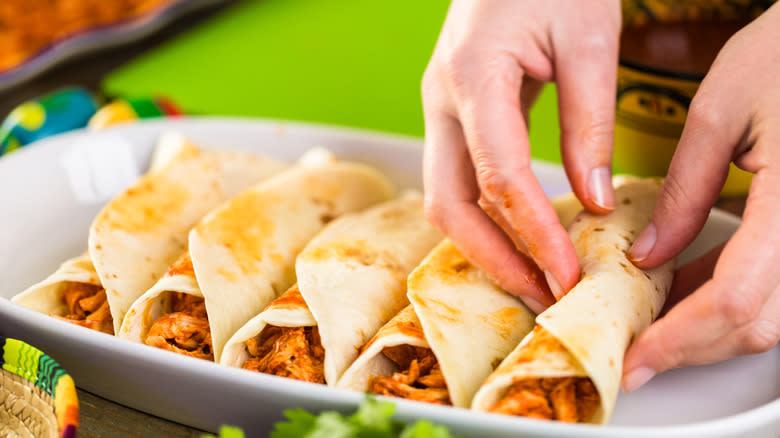
While adding a lot of filling to enchiladas may make them taste extra delicious, it can also make them much harder and messier to eat. Overstuffed tortillas often crack or break, making them difficult to remove from the baking dish once they are ready to serve. Because the enchilada filling also releases steam as it cooks (like the sauce), too much of a good thing can lead to a mushy result.
So how do you strike the perfect balance between understuffed enchiladas that leave you wanting more and overstuffed enchiladas that are a soggy mess? As you're assembling the enchiladas, pay attention to how much filling you're using for every tortilla and aim for consistency. Many high-rated recipes call for anywhere between a few tablespoons and ⅓ cup of filling. This ensures the enchiladas all cook evenly and also helps the tortillas stay intact without bursting or breaking in the oven.
Forgetting The Cooking Spray On Your Pan
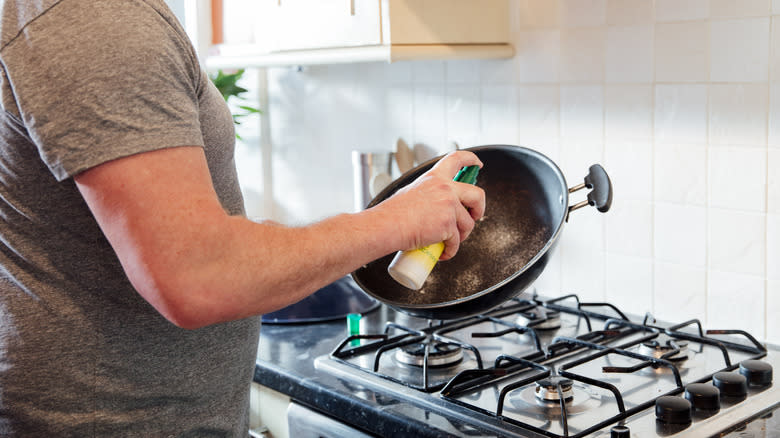
If you plan to bake your enchiladas in a casserole dish, don't forget a vital, often-overlooked element: cooking spray. Like with any meal, cooking spray helps prevent your tortillas from adhering by creating a barrier between the food and the surface of the baking dish. This makes your enchiladas much easier to serve and also helps speed up the cleanup process by eliminating burnt bits.
If you prefer, you can swap in other alternatives for cooking spray, like butter, lard, or oil. Neutral oils, like avocado, canola, or grapeseed are the best options, while more flavorful options like olive, peanut, or sesame should be avoided. Just be sure to choose a substitute oil with a high enough smoke point for your recipe to prevent the bottom from burning. Remember to skip the spray (or spray alternative) if you're using a nonstick dish since it is inherently designed to help prevent sticking.
Covering The Enchilada Dish With Foil
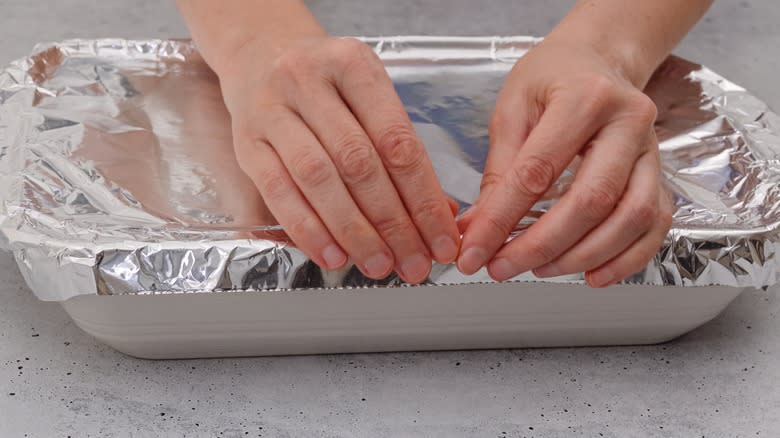
Many recipes call for covering enchiladas with aluminum foil while they bake. This common kitchen tactic helps lock in moisture and prevents the top layer from burning — especially at high heat. This is especially important for slow-cooked dishes that are in the oven for hours like stews, ribs, or braised meat like brisket or pork shoulder. While this may work well for other dishes like casseroles, using foil with enchiladas prevents the steam from releasing and the sauce from evaporating as quickly. This, in turn, causes the tortillas to absorb excess moisture while in the oven, leading to a mushy final product.
Heating enchiladas uncovered is one of the best ways to avoid unwanted sogginess. Since enchiladas are in the oven for a relatively short duration (usually less than 30 minutes), the risk of burning the top layer or drying them out completely is minimal. If the surface starts to burn near the end of the cooking time, only add foil while the enchiladas finish baking.
Skipping Extra Toppings
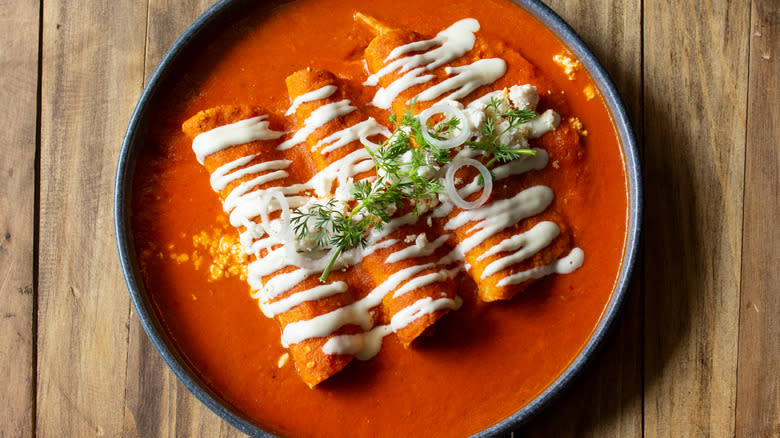
Enchiladas are delicious on their own, but garnishes and toppings can really take them over the top. Additions like crema, red onion, cilantro, avocado, or pico de gallo add texture to the dish and enhance the classic Mexican flavors. Opt for these combinations or play around with toppings to find your favorite garnish for your homemade enchiladas.
"I usually prefer queso fresco or shredded cheese and onions and maybe some cilantro if I'm feeling fancy," said Marques-Sharpnack. "If the sauce is very spicy, I like to drizzle some crema Mexicana or add a dollop of sour cream. If they are red enchiladas, I love a fried egg on top!" Curiel recommends similar accouterments. "My favorite toppings for a green enchilada are always crema Mexicana, queso fresco, and diced raw onion," he said. "If it's a red enchilada, I would switch out queso fresco or cotija for more brightness and add lettuce tossed in lime to cut through the richness and bitterness of a dried pepper."
Read the original article on Mashed


